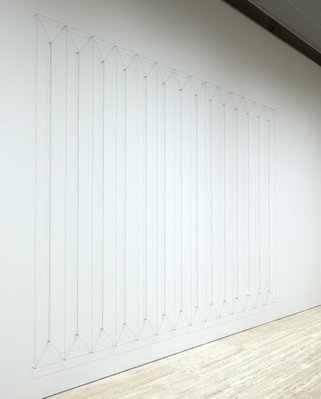


-
Details
- Date
- 1971
- Media category
- Installation
- Materials used
- industrial cotton string and nails
- Dimensions
- 290.2 x 482.4 x 6.0 cm
- Credit
- Purcahsed with funds provided by the Mervyn Horton Bequest and the Roger Pietri Fund 2019
- Location
- Not on display
- Accession number
- 103.2019
- Copyright
- © Kazuko Miyamoto
- Artist information
-
Kazuko Miyamoto
Works in the collection
- Share
-
-
About
Born in Tokyo during the second world war, Miyamoto moved to the United States in 1964 to study at the Art Students League, New York. In 1968 she rented her first studio and began making minimal and conceptual work influenced, in part, by artists Sol LeWitt and Adrian Piper whose studios were located in the same building. Miyamoto subsequently formed a strong friendship with LeWitt and became one of his first assistants, working on the production of his wall drawings and open cube sculptures (important examples of which are held in the Collection).
‘Untitled II’ 1971 is an important, early wall work by Miyamoto that is emblematic of her use of thread to create works that articulate both line and volume in space. Contemporary with Fred Sandback, who was working on the West Coast while Miyamoto was active in New York, she developed an idiosyncratic version of minimal art that hovered between sculpture and drawing. According to the artist,’ Untitled II’ was first installed on a white brick wall at Sol Lewitt's apartment and was the moment that she first came to the attention of the New York art world.
While Miyamoto’s work is unquestionably informed by LeWitt’s wall drawings, there are significant differences between their practices, most notably the manner in which her wall works project into the space. As influential British curator and critic wrote in the catalogue for the artist’s 1977 exhibition at Ginza Kaigakan, Tokyo:
“[Miyamoto] worked on [LeWitt’s] drawings at the Guggenheim Museum in 1971, for example, and LeWitt’s definition of the wall certainly influenced her. Hers was not a simple action of imitation, however: on the contrary she pursued, with relentless subtlety, a three-dimensional potential implicit in the drawings but not realized by LeWitt. Kazuko was originally a painter and she preserves a painter’s sense of spatial illusion within her sculptural constructions. Literal and illusive elements, sculptural means and pictorial effects, are brilliantly fused.”Furthermore, the unique, sculptural qualities of Miyamoto’s thread works bring them into dialogue with contemporaries working outside the context of New York’s minimal and conceptual movements. The work of Japanese-American Ruth Asawa (1926-2013), Venezualan Gego (1912-1994), and Brazilian Lygia Pape (1927-2004) are important touchstones for a consideration of Miyamoto’s work and reveal her relationship to a global network of so-called minimal artists working in the 1960s and 1970s.
Significantly, since the beginning of her practice, Miyamoto has also been involved in discussions of racial and gender politics and organised initiatives that sought to address implicit biases at play in the New York art world. In 1972, by way of example, the same year that she executed the proposed work, Miyamoto was a founding member of A.I.R. Gallery – the first all-woman artist-run cooperative in the United States. Subsequently, in 1980, with fellow artists Ana Mendieta and Zarina she critiqued the predominantly white membership of A.I.R by organising ‘Dialectics of Isolation: An Exhibition of Third World Women Artists in the United States’ – an exhibition that foregrounded the work of women of colour.
-
Exhibition history
Shown in 4 exhibitions
Kazuko Miyamoto, Circuit, Lausanne, 14 Nov 2015–19 Dec 2015
Kazuko Miyamoto, Take Ninagawa, Minatoku, 22 Sep 2018–10 Nov 2018
Some mysterious process, Art Gallery of New South Wales, Sydney, 01 Jun 2020–13 Sep 2020
20th-Century galleries, lower level 1 (rehang), Art Gallery of New South Wales, Sydney, 20 Aug 2022–2023




